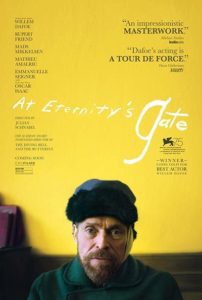Though he was playing a man who was about 25 years younger than his actual age, I could not imagine an actor doing a better job portraying the Dutch Post-impressionist painter Vincent Van Gogh than Willem Dafoe (Platoon, The Boondock Saints). It’s a performance that will net Dafoe his third Best Actor nomination (he also has a Best Supporting Nom for 2017’s The Florida Project), and it could be the one that nets him his first Oscar win. While I don’t think it will happen (and I don’t have a particular reason why in this year’s wide-open field), it will be a movie that many people will see who might not otherwise be interested in a biopic on this person. At Eternity’s Gate worked for me. I am often willing to give a biopic a chance unless I find many of the film’s portrayals fictionalized. I don’t think anything upsets me more than a story claiming to be true that turns out to be anything but factual. Fortunately, that wasn’t the case with Julian Schnabel’s (The Diving Bell and the Butterfly, Lou Reed’s Berlin) stylistic character study of one of the most famous and mystifying artists of all time. Filmed as artistically as Van Gogh lived his life, Schnabel exceeded the confines of a conventional biopic and created something that felt new and refreshing, regardless of the darkness in which Van Gogh lived.

Schnabel isn’t much of a household name. I think most people have at least heard of The Diving Bell and the Butterfly, but most probably have not seen it. He isn’t known for much else. His last movie was 2011’s Miral. It bombed, both at the box office and with the critics. But sometimes, good things come to those who wait. It’s unlikely that his newest film will earn him his first Best Director Oscar nomination, nor will his film likely be mentioned when the Best Picture nominations come out. But if he’s the man behind the movie that nets Dafoe his most recent Best Actor nomination (and maybe a win), that could win enough for him.
At his first hospitalization, Theo traveled the better parts of a day and a half just to hold his brother in his hospital bed and tell him everything would be okay. But he knew that to be further from the truth. Two quotes from Vincent stood out in this movie. The first was, “I feel like I’m losing my mind.” Depression is terrible enough on its own. To feel like everything is spinning out of control without the ability to stop it must be ten times worse. A feeling of an uncertain future has to be incredibly debilitating. The other quote was when Vincent told his doctor, “Maybe God made me a painter for people who aren’t here yet.” Nothing could have been more accurate.
Theo also paid money to fellow artist Paul Gauguin (Oscar Isaac – Ex Machina, Inside Llewyn Davis) to establish a friendship with Vincent and to watch over him in a way since he was so far away he could not do so. The two hit it off at first but then frequently clash as they have different views on art. Gauguin, who was successful during his career, argued that art should be a calculated and deliberate approach. Slow and steady, if you will. Vincent felt like everything had to occur quickly, freely, and spontaneously…almost like a madman. It seems stupid that this was the basis of their quickly deteriorating friendship, but there it is.
I’ve seen the movie compared to both Mr. Turner and My Left Foot regarding how it depicted the lead artist in terms of personality, creative process, and the toll it took on them. First of all, Mr. Turner was a terrible movie in every regard, and My Left Foot was both unique and painful to watch. I understand why Daniel Day-Lewis won an Oscar for it, but I did not enjoy this movie at all. At Eternity’s Gate, while slow at times, it never felt truly dull. Maybe it was that I felt connected with Van Gogh more than the leads in those other two movies, or perhaps it was because everything, while artistic, was reasonably straightforward. Dafoe, who, sometimes as an actor, can come across as wild, bizarre, and (frankly) unenjoyable in some of his friends, was almost given free rein to portray Vincent as the emotionally needy loner and narcissist with very low self-esteem. He did not go overboard with this performance. He teetered that fine line perfectly of the likable protagonist you cheer for who has that tragic flaw that you just know will doom him.
Willem Dafoe plays Van Gogh, and he’s uniquely suited to the task. He’s a captivating performer, expressive with his body language like Van Gogh was with a brush. In lesser material, Dafoe can sometimes come across as wild, even bizarre, but in a production like “At Eternity’s Gate,” he’s free to make Van Gogh an emotionally needy loner and an egomaniac with low self-esteem. Everything in Van Gogh’s life was gigantic… except for his impact while he was alive.
And, without giving away a spoiler, I will say that this film ended abruptly and in a way that is a bit inconsistent with what we know about the end of Vincent’s life. See At Eternity’s Gate for its performance. You may walk away enjoying the film in the process.
Plot 9/10
Character Development 8/10
Character Chemistry 8.5/10
Acting 9/10
Screenplay 8/10
Directing 8/10
Cinematography 10/10
Sound 10/10
Hook and Reel 8/10
Universal Relevance 8.5/10
87%